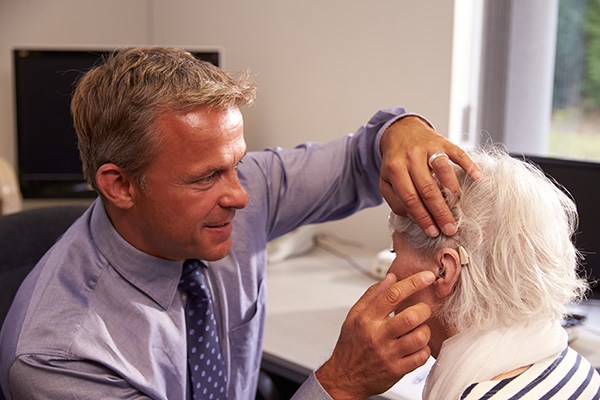How to Choose the Best Hearing Aid for Your Lifestyle
Choosing the right hearing aid isn’t just about finding something

By: admin | March 21, 2025
Have you ever noticed how your ears do more than just help you hear? That’s because your ears play a crucial role in two important systems: hearing and balance. We often don’t make the connection between these two functions, but they’re closely linked within the same part of our body. The inner ear contains specialized structures that let us detect sounds while also helping us stay steady on our feet.
When we think about health, it’s easy to overlook our hearing. Yet how we hear affects how we communicate, stay safe and interact with our environment. And because hearing and balance share the same systems, problems with one can sometimes affect the other. Taking care of your hearing isn’t just about protecting your ability to enjoy music or conversation – it’s about maintaining your overall wellness, including your sense of balance and spatial awareness.
Our ability to hear begins with sound waves traveling through the environment, which are then captured by the outer ear. The outer ear consists of the visible part called the pinna, which helps direct sound into the ear canal. This sound energy travels down the ear canal and reaches the eardrum, causing it to vibrate. The vibrations from the eardrum are passed to three tiny bones in the middle ear, known as the ossicles. These bones amplify the vibrations and transmit them to the inner ear, where the real magic of hearing takes place.
The inner ear, particularly the cochlea, is responsible for converting these vibrations into electrical signals. The cochlea is a spiral-shaped, fluid-filled structure that houses tiny hair cells. As the fluid inside the cochlea moves in response to vibrations, the hair cells bend. This bending triggers electrical impulses that are sent along the auditory nerve to the brain. The brain then interprets these signals as sound, allowing us to recognize and respond to different noises. The cochlea is organized in such a way that it processes different sound frequencies, much like the keys on a piano, allowing us to hear a wide range of pitches.
To maintain clear hearing, the ear has several mechanisms that help protect and regulate its function. The ear canal, lined with fine hairs and a small amount of earwax, helps protect the delicate structures inside the ear from dirt and bacteria. The middle ear, separated from the outer ear by the eardrum, houses the ossicles and is connected to the throat by the Eustachian tube. This tube helps equalize air pressure between the middle ear and the outside environment, which is especially important during activities like flying. Through this coordinated system, our ears work together to ensure we can hear the sounds around us accurately and clearly.
Sound waves are vibrations that travel through the air, and they begin their journey when an object moves or vibrates, creating a disturbance in the surrounding air molecules. These disturbances form a pressure wave, which moves outward from the source in all directions. The sound waves travel in different frequencies and amplitudes, determining the pitch (high or low sound) and volume (loud or soft sound) of the sound we perceive. As the sound waves travel through the air, they are captured by the outer ear, where the pinna (the visible part of the ear) directs them into the ear canal toward the eardrum.
Upon reaching the eardrum, the sound waves cause it to vibrate. These vibrations are then passed to the ossicles, three tiny bones located in the middle ear. These bones – the malleus (hammer), incus (anvil) and stapes (stirrup) – amplify the vibrations and transmit them to the cochlea, a spiral-shaped structure in the inner ear. The stapes, the smallest bone, makes contact with the oval window of the cochlea, a membrane-covered opening. When the stapes moves, it creates ripples in the fluid inside the cochlea, setting the fluid into motion and preparing the cochlea to process the sound.
Inside the cochlea, specialized sensory cells called hair cells are responsible for converting the vibrations into electrical signals. As the fluid inside the cochlea moves, it causes the hair cells to bend, and this bending triggers the release of electrical impulses. These impulses travel along the auditory nerve to the brain, which interprets them as sound. The cochlea is organized so that different parts respond to different frequencies, similar to how a piano’s keys are tuned to specific pitches. The brain uses these signals to recognize and understand the sounds we hear, allowing us to identify voices, music and environmental noises with remarkable clarity.
Hearing and balance are closely connected through the inner ear, where both functions are controlled by specialized structures. The cochlea, responsible for hearing, and the vestibular system, which manages balance, are located within the same region of the inner ear. While the cochlea processes sound, the vestibular system consists of three semicircular canals filled with fluid that detect head movements. These canals help the brain understand changes in position, like tilting or turning the head, which allows us to maintain balance. The fluid inside the semicircular canals moves as the head shifts, stimulating hair cells that send signals to the brain, helping it assess orientation and movement.
Although hearing and balance are controlled by different parts of the inner ear, they share the same neural pathways to the brain. The brain receives information from both systems and uses it to coordinate how we hear sounds and maintain physical stability. When there is a disruption in the vestibular system, it can lead to dizziness, vertigo or difficulty with coordination, while issues with the cochlea affect hearing. Since these systems are so closely linked, any condition that impacts one can also have an effect on the other, underscoring the importance of keeping both auditory and balance functions healthy.
Vertigo is often linked to issues within the inner ear, where both hearing and balance are controlled. The inner ear houses a tiny but important structure called the vestibular system. This system includes three semicircular canals filled with fluid and lined with tiny hair cells, similar to those found in your cochlea for hearing. These canals detect movement of your head and help maintain balance by sending signals to your brain about your body’s position.
Understanding how these inner ear functions relate to vertigo can provide insight into why you might be experiencing these dizzy spells. If you’re experiencing symptoms like vertigo along with changes in hearing, it’s important to discuss them with a hearing health professional.
When hearing loss occurs, it can disrupt the connection between the auditory and balance systems in the inner ear, leading to difficulties with spatial awareness and balance. The vestibular system, responsible for maintaining equilibrium, relies on signals from the cochlea to detect head movements and assess body positioning. When hearing loss affects the cochlea or auditory nerve, the brain may receive incomplete or inaccurate information, which can result in feelings of unsteadiness or dizziness. In these situations, individuals may find it challenging to maintain balance, especially in environments where they would normally rely on sound for orientation, like when walking through a crowded area or moving between rooms.
Hearing and balance problems can be caused by a variety of factors, ranging from age-related changes to injuries or infections. One common cause is age-related hearing loss, also known as presbycusis, which occurs as the structures of the inner ear gradually deteriorate over time. This condition can affect both hearing and balance, as the inner ear plays a key role in both functions. Other causes of hearing loss and balance issues include ear infections, particularly those that affect the inner ear or the vestibular system. Infections such as labyrinthitis or vestibular neuritis can lead to dizziness, balance disturbances and hearing loss.
Certain medical conditions can also contribute to hearing and balance problems. For example, Meniere’s disease, a disorder that affects the inner ear, is known to cause episodes of vertigo, hearing loss and ringing in the ears (tinnitus). Another condition, otosclerosis, involves abnormal bone growth in the middle ear and can lead to progressive hearing loss and sometimes balance difficulties. Other systemic conditions, like diabetes or high blood pressure, can also negatively impact the ear’s ability to function properly, contributing to both hearing and balance problems.
Recognizing the early signs of hearing loss and balance disorders is crucial for maintaining optimal ear health and preventing further complications. Early symptoms of hearing loss can include difficulty hearing conversations, particularly in noisy environments or asking people to repeat themselves often. Another sign might be a feeling of fullness or pressure in the ears, which can sometimes indicate issues with the inner ear or middle ear. If balance problems arise, individuals may experience unsteadiness, dizziness or a sensation of spinning, known as vertigo. In some cases, they may also notice difficulty walking in a straight line, a sense of imbalance or feeling like they might fall.
If any of these symptoms are observed, it’s important to seek advice from a hearing specialist or healthcare professional. They can help identify the underlying cause of the problem, whether it’s related to age, an infection, a medical condition or medication side effects. Early intervention can lead to more effective treatment and management of the condition, preventing further hearing or balance decline. A hearing specialist may recommend tests to evaluate both auditory and balance function, providing a comprehensive understanding of the issue.
Hearing changes can often go unnoticed until they start to affect our daily lives. When these signs become apparent, it’s time to seek advice from a hearing specialist. They use advanced tools and techniques to assess your hearing health and provide solutions tailored to your needs. Whether it’s a hearing aid, therapy or a different approach, a hearing specialist can offer personalized recommendations that improve your overall quality of life. Timely intervention not only helps preserve your hearing but also supports your ability to stay connected with the world around you.
One effective measure is limiting exposure to loud noises. Regular check-ups with a hearing specialist are also important as these professionals can help monitor your hearing health and provide guidance on preventive care.
Maintaining a healthy lifestyle plays a significant role in preserving both your hearing and balance systems. Medications are another factor worth considering as certain drugs can potentially harm inner ear structures leading to issues with hearing or balance.
Our ears do much more than just help us hear – they are integral to our sense of balance and stability. Since hearing and balance share the same structures, issues with one can often affect the other. For example, hearing loss may lead to feelings of unsteadiness, while balance problems can make simple tasks like walking or standing more difficult. Protecting your hearing isn’t just about enjoying conversations or music; it’s also about maintaining your overall well-being and mobility.
If you notice changes in your hearing or balance, don’t hesitate to seek professional advice. The specialists at Coastal Hearing Clinic in Sandwich, MA are here to help you understand these changes and guide you towards effective solutions. To schedule an appointment and get to the bottom of your symptoms, please give us a call at (774) 445-6655.

Choosing the right hearing aid isn’t just about finding something
By: admin | November 18, 2025

When a child has hearing loss, it affects far more than just their ability
By: admin | September 24, 2025

When we think about threats to our hearing health, loud concerts or aging
By: admin | April 24, 2025
